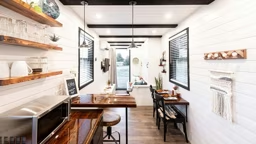So you want to build a cabin. Whether you hire out the whole project or decide to be an owner-builder (and, therefore, your own contractor), you will need to know how the whole process works.
From getting started to ordering materials, here are some tips and pointers culled from “The Complete Idiot’s Guide to Building Your Own Home.”
• You can save thousands of dollars by selecting a stock plan and having it modified by an architect or drafting service to fit your needs.
• Contractors typically require four to six months to build a home. Owner-builder homes typically take nine to 24 months to build, so plan accordingly.
• Concrete slabs typically cost less than concrete perimeter foundations. Depending on local building codes, site soil and your home’s design, you may be able to save with a slab foundation.
• Plastic film is typically left intact on doors and windows to protect them from the painters. Exterior painters will spray everything in sight, including doors and windows if they aren’t covered.
• For less than $20, you can get a few hundred business cards printed up with your name, the building site location, your contractor’s or adviser’s name and phone numbers, and any other information you should share with others. … Letting people know how to contact you and the other decision-makers in your construction will make things go more smoothly.
• Call your subcontractors the evening before they are scheduled to be on your site to confirm arrival time. And get their cell phone number in case they don’t show up. Make sure they have your cell number, too.
From getting started to ordering materials, here are some tips and pointers culled from “The Complete Idiot’s Guide to Building Your Own Home.”
• You can save thousands of dollars by selecting a stock plan and having it modified by an architect or drafting service to fit your needs.
• Contractors typically require four to six months to build a home. Owner-builder homes typically take nine to 24 months to build, so plan accordingly.
• Concrete slabs typically cost less than concrete perimeter foundations. Depending on local building codes, site soil and your home’s design, you may be able to save with a slab foundation.
• Plastic film is typically left intact on doors and windows to protect them from the painters. Exterior painters will spray everything in sight, including doors and windows if they aren’t covered.
• For less than $20, you can get a few hundred business cards printed up with your name, the building site location, your contractor’s or adviser’s name and phone numbers, and any other information you should share with others. … Letting people know how to contact you and the other decision-makers in your construction will make things go more smoothly.
• Call your subcontractors the evening before they are scheduled to be on your site to confirm arrival time. And get their cell phone number in case they don’t show up. Make sure they have your cell number, too.
• It’s a good idea to have a backup supplier. If your job can’t go ahead without a specific material, it may be less costly to order it from another supplier at a higher cost than to have people standing around while you pay them.
• Remember, actual dimensions (width and depth) of lumber is less than the nominal dimensions, depending on the type of wood and whether it is dried or not. For example, a 2x4 nominal may actually measure 15/8 x 35/8 inches.
• Because framing requires as much manpower as skill, many owners hire themselves to their framing contractor to help out and save money. A typical framing crew is two or three people, including the lead framer or boss. If you’re hired as a helper, be prepared to work harder than more experienced workers.
• Don’t hurt your back lifting a heavy wall into place. Instead, rent or buy wall jacks. They attach to an extra stud and work just like a car’s lever jack to raise the wall. If wall jacks aren’t an option, get lots of strong folks to help lift the wall.
• Your window schedule may include a “2442” or other listing. It means that the window sash is 2'4" wide and 4'2" high. The window opening in the wall frame might be larger depending on whether the window is wood or metal. Check the plans or ask your window supplier about rough opening dimensions.
• Professional roofers install both flash and counter-flash. Flash is L-shaped and fits in the valley between two roofs or around a chimney. Counter-flash is mounted at the top edge of the flash to keep water from seeping behind it. Cheap insurance!
• Roofing materials are commonly sold in squares. A square of roofing is the amount required to cover 100 square feet. (That’s three bundles of standard fiberglass shingles and one roll of 90-pound mineral-rolled roofing.) Get the total square feet of roof surface and divide it by 100 to get the number of squares needed.
• Most lines of paints include three quality grades: professional, standard and premium. The best is usually the premium grade rather than the professional grade, which is typically made to be the least expensive to keep costs down.
• Don’t bury trash on the building site. Not only is it illegal in most places, it also is not a good idea. Lumber scrap can become the new home of termites and other pests. Gypsum and paints can leach into the water table. Concrete can get in the way when installing landscaping. Recycle it instead!
Excerpted from “The Complete Idiot’s Guide to Building Your Own Home (Second Edition),” by Dan Ramsey, published by Alpha Books, 2005.
• Remember, actual dimensions (width and depth) of lumber is less than the nominal dimensions, depending on the type of wood and whether it is dried or not. For example, a 2x4 nominal may actually measure 15/8 x 35/8 inches.
• Because framing requires as much manpower as skill, many owners hire themselves to their framing contractor to help out and save money. A typical framing crew is two or three people, including the lead framer or boss. If you’re hired as a helper, be prepared to work harder than more experienced workers.
• Don’t hurt your back lifting a heavy wall into place. Instead, rent or buy wall jacks. They attach to an extra stud and work just like a car’s lever jack to raise the wall. If wall jacks aren’t an option, get lots of strong folks to help lift the wall.
• Your window schedule may include a “2442” or other listing. It means that the window sash is 2'4" wide and 4'2" high. The window opening in the wall frame might be larger depending on whether the window is wood or metal. Check the plans or ask your window supplier about rough opening dimensions.
• Professional roofers install both flash and counter-flash. Flash is L-shaped and fits in the valley between two roofs or around a chimney. Counter-flash is mounted at the top edge of the flash to keep water from seeping behind it. Cheap insurance!
• Roofing materials are commonly sold in squares. A square of roofing is the amount required to cover 100 square feet. (That’s three bundles of standard fiberglass shingles and one roll of 90-pound mineral-rolled roofing.) Get the total square feet of roof surface and divide it by 100 to get the number of squares needed.
• Most lines of paints include three quality grades: professional, standard and premium. The best is usually the premium grade rather than the professional grade, which is typically made to be the least expensive to keep costs down.
• Don’t bury trash on the building site. Not only is it illegal in most places, it also is not a good idea. Lumber scrap can become the new home of termites and other pests. Gypsum and paints can leach into the water table. Concrete can get in the way when installing landscaping. Recycle it instead!
Excerpted from “The Complete Idiot’s Guide to Building Your Own Home (Second Edition),” by Dan Ramsey, published by Alpha Books, 2005.
Builders Vocabulary
owner-builder. The general contractor and owner of the land who may hire subcontractors for some or all of the building and who intends to occupy the house.
materials take-off. A detailed list of all materials that are needed to build a specific house. It will include everything from foundation rebar to roof fasteners. Quite a long list!
punch list. A written list of unfinished or incorrectly finished items that must be finished or corrected before the owner will accept the project from the contractor.
platform frame construction. A method that uses the foundation, joists and subfloor as a platform on which the house is built.
balloon frame construction. A method that installs studs directly on top of joists.
stickbuilt houses. Any construction method (such as platform frame or balloon frame) that uses dimensional lumber as the primary building materials.
square foot. An area one foot (12 inches) by one foot, or 144 square inches.
square. 100 square feet.
owner-builder. The general contractor and owner of the land who may hire subcontractors for some or all of the building and who intends to occupy the house.
materials take-off. A detailed list of all materials that are needed to build a specific house. It will include everything from foundation rebar to roof fasteners. Quite a long list!
punch list. A written list of unfinished or incorrectly finished items that must be finished or corrected before the owner will accept the project from the contractor.
platform frame construction. A method that uses the foundation, joists and subfloor as a platform on which the house is built.
balloon frame construction. A method that installs studs directly on top of joists.
stickbuilt houses. Any construction method (such as platform frame or balloon frame) that uses dimensional lumber as the primary building materials.
square foot. An area one foot (12 inches) by one foot, or 144 square inches.
square. 100 square feet.
 Winston Johnson, Highland Log Structures, Inc.
Winston Johnson, Highland Log Structures, Inc.  Winston Johnson, Highland Log Structures, Inc.
Winston Johnson, Highland Log Structures, Inc. 









